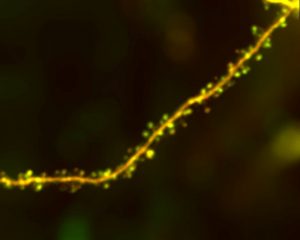
Image of a dendrite with round processes or spines, expressing a red fluorescent protein together with a green tag for the protein Arc, obtained with two-photon microscopy in an awake mouse.
Source: [Picower Institute for Learning and Memory, David Orenstein | June 22, 2018]
Our brains are famously flexible, or “plastic,” because neurons can do new things by forging new or stronger connections with other neurons. But if some connections strengthen, neuroscientists have reasoned, neurons must compensate lest they become overwhelmed with input. In a new study in Science, researchers at the Picower Institute for Learning and Memory at MIT demonstrate for the first time how this balance is struck: when one connection, called a synapse, strengthens, immediately neighboring synapses weaken based on the action of a crucial protein called Arc.
Senior author Mriganka Sur said he was excited but not surprised that his team discovered a simple, fundamental rule at the core of such a complex system as the brain, where 100 billion neurons each have thousands of ever-changing synapses. He likens it to how a massive school of fish can suddenly change direction, en masse, so long as the lead fish turns and every other fish obeys the simple rule of following the fish right in front of it.
“Collective behaviors of complex systems always have simple rules,” said Sur, Paul E. and Lilah Newton Professor of Neuroscience in the Picower Institute and the department of Brain and Cognitive Sciences at MIT. “When one synapse goes up, within 50 micrometers there is a decrease in the strength of other synapses using a well-defined molecular mechanism.”
This finding, he said, provides an explanation of how synaptic strengthening and weakening combine in neurons to produce plasticity.
Multiple manipulations
Though the rule they found was simple, the experiments that revealed it were not. As they worked to activate plasticity in the visual cortex of mice and then track how synapses changed to make that happen, lead authors Sami El-Boustani and Jacque Pak Kan Ip, postdoctoral researchers in Sur’s lab, accomplished several firsts.
In one key experiment, they invoked plasticity by changing a neuron’s “receptive field,” or the patch of the visual field it responds to. Neurons receive input through synapses on little spines of their branch-like dendrites. To change a neuron’s receptive field, the scientists pinpointed the exact spine on the relevant dendrite of the neuron, and then closely monitored changes in its synapses as they showed the mouse a target in a particular place on a screen that differed from the neuron’s original receptive field. Whenever the target was in the new receptive field position they wanted to induce, they reinforced the neuron’s response by flashing a blue light inside the mouse’s visual cortex, instigating extra activity just like another neuron might. The neuron had been genetically engineered to be activated by light flashes, a technique called “optogenetics.”

